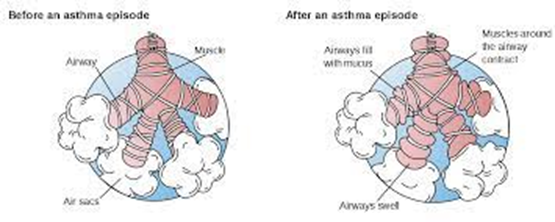A nurse is teaching a student about cerebral edema. The student nurse asks, "What type of cerebral edema is associated with a client who has a stroke?" Which of the following is the best response from the nurse?
Vasogenic cerebral edema
Osmotic cerebral edema
Cellular cerebral edema
Interstitial cerebral edema
The Correct Answer is A
Choice A Reason:
Vasogenic cerebral edema is appropriate response. Vasogenic cerebral edema occurs due to disruption of the blood-brain barrier (BBB), leading to leakage of fluid and proteins from the blood vessels into the brain parenchyma. This type of cerebral edema is commonly associated with conditions such as brain tumors, abscesses, and ischemic stroke.
Choice B Reason:
Osmotic cerebral edema is inappropriate response. Osmotic cerebral edema occurs when there is an imbalance of osmotic forces across the blood-brain barrier, leading to the movement of water into the brain cells. This type of cerebral edema can result from conditions such as hyponatremia or the administration of hypertonic solutions.
Choice C Reason:
Cellular cerebral edema is inappropriate response. Cellular cerebral edema involves the swelling of brain cells (neurons and glial cells) due to various insults, such as ischemia, hypoxia, or metabolic disturbances. This type of cerebral edema can occur in conditions such as ischemic stroke or traumatic brain injury.
Choice D Reason:
Interstitial cerebral edema is incorrect response. Interstitial cerebral edema involves the accumulation of fluid within the interstitial spaces of the brain tissue. This type of cerebral edema can occur in conditions such as hydrocephalus, where there is obstruction of cerebrospinal fluid (CSF) flow.
Nursing Test Bank
Naxlex Comprehensive Predictor Exams
Related Questions
Correct Answer is C
Explanation
Choice A Reason:
Decreased mucus production contributes to airway constriction: This statement is incorrect. Bronchospasm does not decrease mucus production; instead, it primarily affects the smooth muscles surrounding the bronchioles, leading to their constriction and narrowing of the airways. Increased mucus production, often accompanied by inflammation, can contribute to airway obstruction in conditions like asthma.
Choice B Reason:
Inflammation is reduced due to airway diameter: This statement is incorrect. Bronchospasm typically occurs in the setting of inflammation in conditions such as asthma. Constriction of the airways during bronchospasm exacerbates the inflammation and can further narrow the airways, leading to symptoms such as wheezing and dyspnea.
Choice C Reason:
Bronchospasm occurs when there is inflammation, edema, and excess mucus: This statement is partially correct. Bronchospasm often occurs in the presence of inflammation, edema, and excess mucus production, as seen in conditions like asthma. These factors contribute to airway hyperresponsiveness, leading to bronchospasm and airway narrowing.
Choice D Reason:
Airway obstruction occurs due to thinning mucus: This statement is incorrect. Airway obstruction in conditions like asthma is primarily due to bronchospasm, inflammation, and excessive mucus production, rather than thinning mucus. Thinning of mucus would not typically contribute to airway obstruction.

Correct Answer is ["B","D","E"]
Explanation
Choice A Reason:
Loss of teeth is not typically considered a direct factor contributing to obstructive sleep apnea. While the presence of teeth may play a role in maintaining the structure of the oral cavity, it is not a primary risk factor for OSA.
Choice B Reason:
Stroke is correct. Individuals who have had a stroke are at increased risk of developing obstructive sleep apnea. Stroke can cause damage to areas of the brain involved in controlling breathing and upper airway function, leading to disruptions in respiratory control during sleep.
Choice C Reason:
Sleepiness is a symptom commonly associated with obstructive sleep apnea rather than a direct contributing factor. Excessive daytime sleepiness is a consequence of disrupted sleep patterns and recurrent episodes of breathing cessation during the night, which are characteristic features of obstructive sleep apnea.
Choice D Reason:
Fatty deposits is correct. Excessive fatty deposits, particularly around the neck and throat, can contribute to the narrowing and collapse of the upper airway during sleep, increasing the risk of obstructive sleep apnea. Obesity is a significant risk factor for OSA due to the accumulation of fat deposits in the upper airway tissues.
Choice E Reason:
Muscle dysfunction is correct. Muscle dysfunction, particularly of the muscles surrounding the upper airway, can impair the ability of these muscles to keep the airway open during sleep. Weakness or dysfunction of these muscles can lead to increased collapsibility of the upper airway, contributing to obstructive sleep apnea.
Whether you are a student looking to ace your exams or a practicing nurse seeking to enhance your expertise , our nursing education contents will empower you with the confidence and competence to make a difference in the lives of patients and become a respected leader in the healthcare field.
Visit Naxlex, invest in your future and unlock endless possibilities with our unparalleled nursing education contents today
Report Wrong Answer on the Current Question
Do you disagree with the answer? If yes, what is your expected answer? Explain.
Kindly be descriptive with the issue you are facing.
